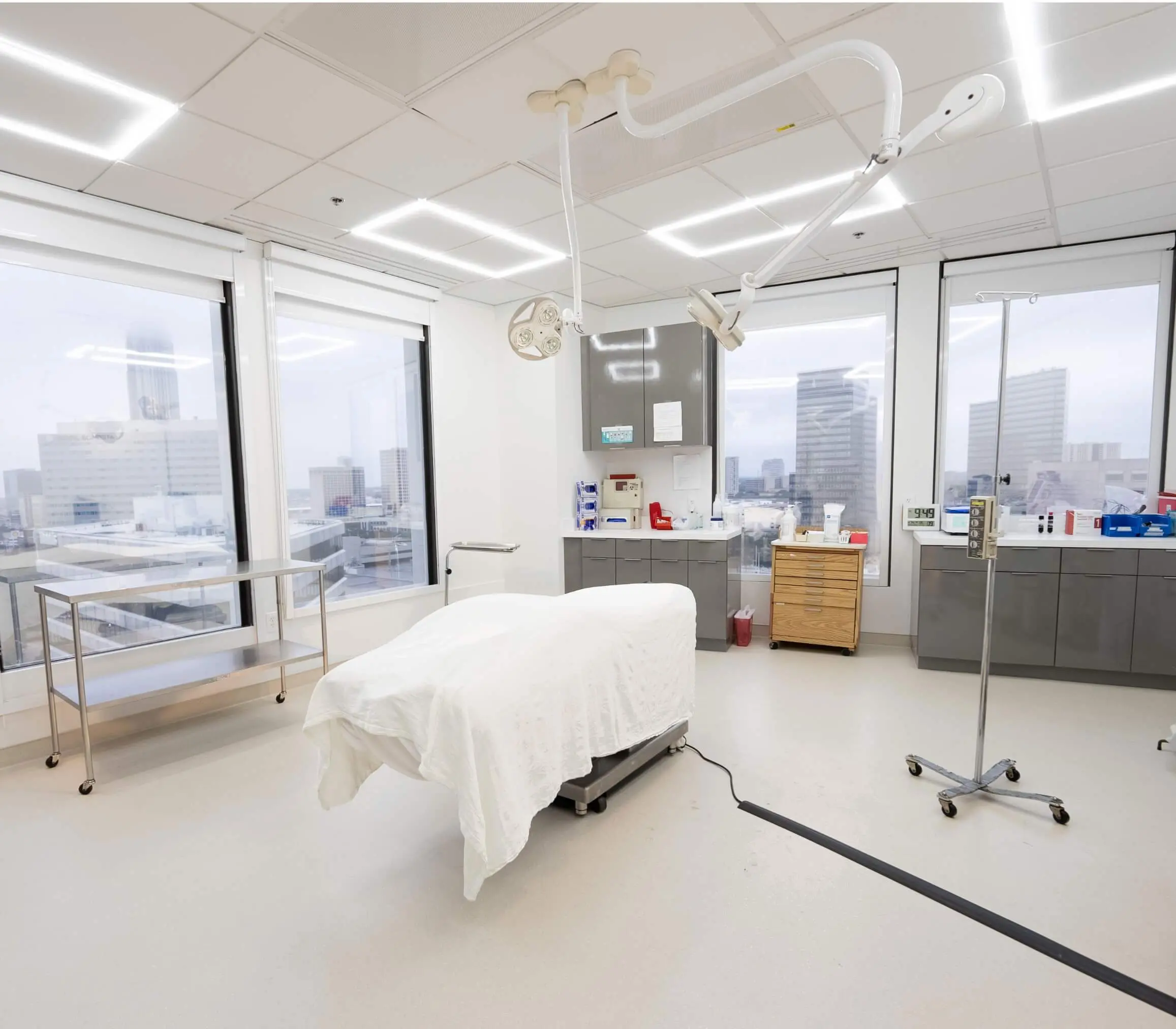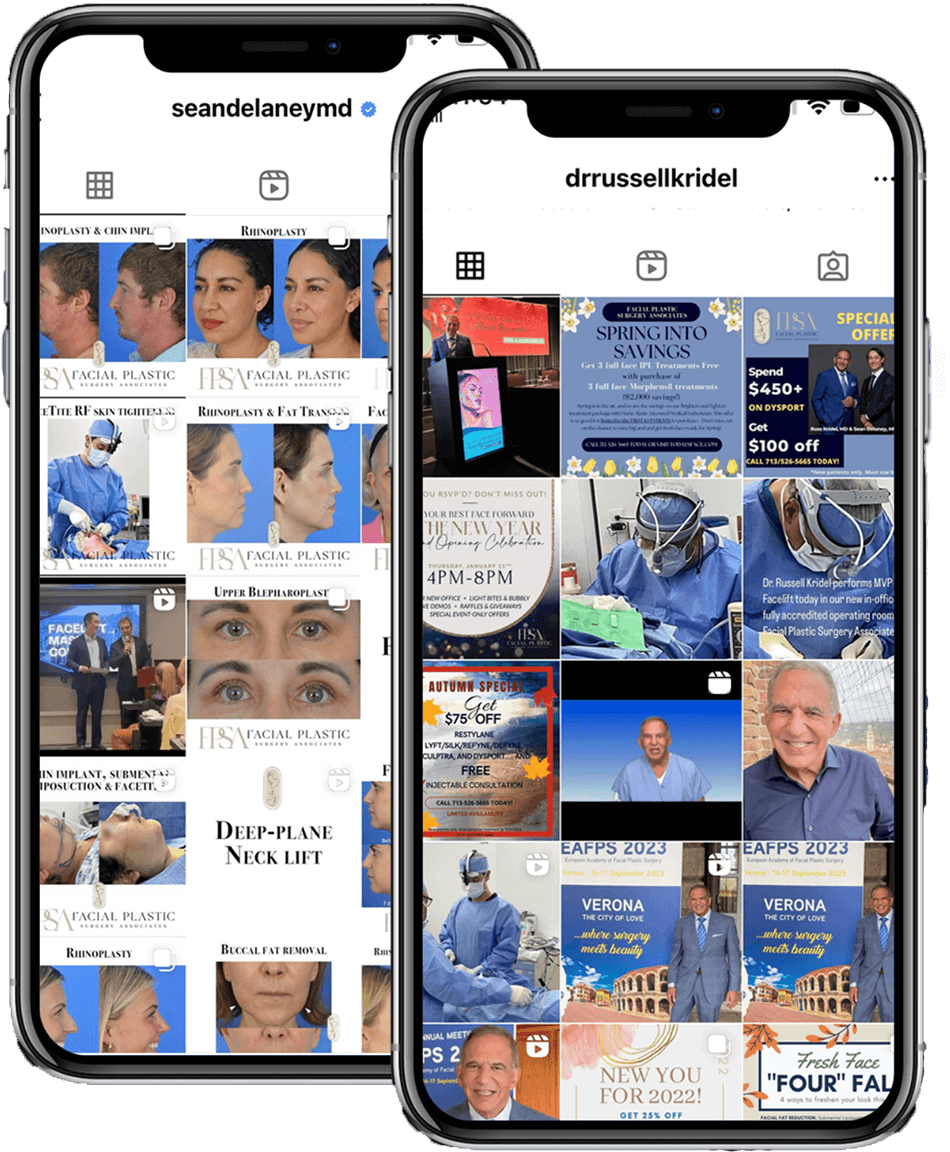 Model
Model
Breast Revision In Houston, TX
Alternatives to breast implants for enhancement include fat transfer breast augmentation, where fat is harvested from another part of the body and injected into the breasts. This method offers a more natural look and feel without the risk of implant-related complications. However, it may provide a more modest increase in breast size compared to implants.
What Is a breast Revision?
Breast revision is a surgical procedure intended to modify the outcome of a previous breast surgery. There are several reasons why individuals may choose to undergo breast revision surgery. Common motivations include implant complications, such as implant rupture, capsular contracture (scar tissue around the implant), or implant displacement, which may develop over time and require correction. Some patients feel dissatisfied with their initial results, particularly regarding the size, shape, or symmetry of their breasts. Additionally, aging, weight fluctuations, or pregnancy can alter the appearance of the breasts, prompting a desire for revision surgery. Others may wish to remove or replace their implants, opting for a different type (saline to silicone, or vice versa) or choosing a more natural appearance without implants.
Since breast revision surgery is highly personalized, the approach taken will depend on the patient’s goals and the complexities of their original breast procedure.
Who Is a Candidate for a breast Revision surgery?
Women experiencing dissatisfaction or complications from a previous breast surgery may be candidates for breast revision. Ideal candidates typically include individuals who:
- Are in good physical health
- Are experiencing implant complications (capsular contracture, implant rupture, asymmetry, etc.)
- Wish to alter breast size or shape
- Have undergone significant physical changes that have altered initial breast procedure results
- Have realistic expectations
It’s essential for patients considering breast revision to consult with a qualified plastic surgeon to determine their suitability for the procedure.
What Are the Benefits of breast Revision?
Breast revision surgery may offer the following benefits:
- Improved breast symmetry
- Enhanced comfort
- Aesthetic satisfaction with size, shape, or implant position
- Long-lasting results
Whether the goal is to resolve implant-related complications or simply refine the aesthetic outcome, breast revision offers a tailored solution that aligns with the patient’s needs.

 Model
Model
What Are My Breast Revision Options?
Breast revision surgery offers a range of options depending on your goals and the issues you’re facing. Some of the most common breast revision options include:
● Implant Replacement: Many patients choose to replace their current implants with a different size, type, or implant shape. Patients may also choose to get the same type of implants they previously had and simply switch out their older implants for new implants.
● Implant Removal: For those who no longer desire breast implants, removal is an option. In many cases, this is often combined with a breast lift to restore a youthful appearance.
● Correction of Capsular Contracture: Capsular contracture occurs when scar tissue forms around the implant, causing tightness or discomfort. This condition can be corrected with a capsulotomy (partial removal of the scar tissue capsule) or capsulectomy (entire removal of the capsule).
● Symmetry Correction: Some patients experience asymmetry after their initial surgery, which can be corrected by repositioning the implants or adjusting the breast tissue.
● Implant Repositioning: If an implant has shifted from its original position, breast revision can reposition it to create a more natural appearance.
The options available will depend on the specific concerns you’re addressing and your desired outcome.
How Is a breast Revision Performed?
Dr. Hamati will tailor your breast revision surgery to address the individual concerns and goals of the patient. The technique used depends on the specific issue being corrected. Here’s an overview of some common approaches:
- Implant Replacement: If the patient wants to change the size or type of their implants, Dr. Hamati removes the existing implants and replaces them with new ones. Sometimes, the surgeon may need to modify the breast pocket (capsule) to accommodate the new implants.
- Capsulectomy or Capsulotomy: In cases of capsular contracture, the Dr. Hamati removes or releases the scar tissue surrounding the implant. This allows for a more natural look and feel of the breast.
- Implant Removal: For patients who no longer wish to have breast implants, Dr. Hamati can remove them. In some cases, additional procedures like a breast lift may be necessary to restore the breast’s natural shape.
- Breast Tissue Reshaping: When the issue involves asymmetry or poor implant positioning, the surgeon may adjust the position of the implant or reshape the breast tissue to achieve a more balanced appearance.
The complexity of the procedure depends on the specific concerns being addressed, and Dr. Hamati will work closely with you to develop a personalized surgical plan.
Initial Consultation
The breast revision process begins with an initial consultation with Dr. Hamati. During this appointment, you’ll have the opportunity to discuss any concerns or issues you’re experiencing with your current breast implants or results. The surgeon will review your medical history to assess your overall health and identify any complications from previous surgeries. A physical examination of your breasts will then help the surgeon determine the most effective approach for your revision. Based on your concerns and goals, the surgeon will explain the potential techniques available and provide you with realistic expectations regarding the outcome. This consultation is crucial in determining if breast revision is the right choice for you and outlining the best surgical plan.
Preoperative Instructions
Dr. Hamati will provide detailed preoperative instructions to ensure a smooth breast revision and recovery. Typically, patients are advised to quit or avoid smoking at least a few weeks before and after surgery, as it can hinder the healing process. Additionally, patients may be advised to stop taking certain blood-thinning medications like aspirin and non-steroidal anti-inflammatory drugs (NSAIDs) to reduce the risk of bleeding during surgery. If general anesthesia is used, fasting is required for a specified period before the procedure. It’s also important to arrange transportation and support, ensuring someone will drive you home and assist during the initial recovery phase. Closely following these instructions helps minimize complications and promotes optimal healing.
During the Procedure
The specifics of breast revision surgery vary depending on the techniques used, but the general process follows a structured series of steps. First, the procedure is typically performed under an anesthetic or sedation to keep the patient comfortable throughout surgery. Dr. Hamati then makes an incision, either using the original site from the previous surgery or creating a new one based on the necessary changes. Common incision locations include beneath the breast (inframammary incision) or around the areola (periareolar incision). Dr. Hamati then addresses the identified issues, such as removing or replacing implants, correcting scar tissue, or reshaping the breast tissue for better aesthetics. Once the adjustments are complete, the incision is closed using sutures, with advanced techniques employed to minimize scarring. Afterward, a bandage or surgical bra is applied to protect the breasts and aid in healing. The entire surgery typically takes several hours, depending on the complexity of the revision.

 Model
Model
What Can I Expect During Recovery From a breast Revision?
Recovery from breast revision surgery occurs in stages, with each phase bringing gradual improvements. Full recovery can take several months, and following your surgeon’s postoperative instructions is essential to ensure optimal healing. Here’s what you can generally expect during each stage:
Weeks 1–2
During the initial recovery, rest is essential. Patients typically experience swelling, bruising, and discomfort, which can be managed with prescribed pain medication. Most patients are advised to limit physical activity and avoid lifting heavy objects. Wearing a surgical bra helps provide support and reduce swelling. Follow-up visits with the surgeon will monitor healing progress.
Weeks 3–4
By the third or fourth week, discomfort usually lessens significantly, and swelling starts to subside. Many patients feel comfortable resuming light daily activities, but strenuous exercises and heavy lifting should still be avoided. At this stage, you may begin to see early improvements in the appearance of the breasts.
Months 2–3
Most swelling has diminished by the second to third month, and the final breast shape begins to take form. After consulting with their surgeon, most patients are cleared to return to more vigorous activities, including exercise. Scars continue to fade, and you’ll notice further refinement in the results.
Month 6 and Beyond
By six months, full recovery is generally complete. The breasts have settled into their new position, and the scars continue to fade over time. Follow-up appointments ensure that results are maintained and that no complications arise. At this point, you can usually enjoy the final outcome of your breast revision surgery.
When Will I See My breast Revision Results?
Initial results will be visible within a few weeks after surgery, but final results may take several months to fully emerge. As the swelling subsides and the tissues heal, the breasts will settle into their new shape, providing a more accurate representation of the final outcome. For patients who have undergone implant replacement or removal, the new size and contour will become more apparent over time.
Results from breast revision surgery are generally long-lasting, but factors such as aging, weight fluctuations, and pregnancy can still affect the appearance of the breasts over time.
Breast Revision FAQ
Breast revision surgery can be combined with additional procedures to achieve comprehensive results. Commonly paired surgeries include a breast lift (mastopexy) to address sagging, fat transfer to enhance volume naturally, or body contouring procedures like liposuction or a tummy tuck. Combining these treatments allows patients to address multiple aesthetic concerns in a single surgery, streamlining recovery time while enhancing overall body proportions and appearance. During your consultation, Dr. John Hamati will discuss the best combination of procedures to suit your goals.
Patients may experience some discomfort, particularly in the first week of recovery, but the pain is generally manageable with medication prescribed by your surgeon. Dr. Hamati will inject a long-lasting local anesthetic to help minimize your pain. Swelling, bruising, and tenderness around the surgical area can be expected. Most report that discomfort significantly decreases after the initial recovery period. Your surgeon will provide detailed postoperative care instructions, including pain management strategies, to ensure a smooth recovery. Each patient’s experience with pain can vary, but with proper care, most find the discomfort to be temporary and tolerable.
Breast revision surgery does leave scars, as incisions are necessary to perform the procedure. However, skilled surgeons make every effort to minimize scarring by using discreet incision sites, often in the same location as previous surgeries. Over time, with proper care, scars tend to fade and become less noticeable. Your surgeon will provide tips on scar management to promote optimal healing and reduce the appearance of scars.
As with any surgical procedure, breast revision carries some risks, including infection, bleeding, and complications related to anesthesia. Specific risks include implant rupture, capsular contracture, or changes in nipple sensation. There’s also a possibility of poor wound healing or asymmetry. Choosing a plastic surgeon with extensive experience in breast revision can help minimize these risks. During your consultation, discussing all potential risks and complications with your surgeon is essential for ensuring you fully understand the procedure and can make an informed decision.
The results of breast revision surgery are generally long-lasting, but their duration can vary based on several factors. While the improvements achieved can be permanent, factors such as aging, weight fluctuations, and lifestyle changes can impact the appearance of your breasts over time. Regular follow-ups with your surgeon and proper care of your implants can help maintain the results. Typically, patients enjoy satisfying results for many years, but it’s important to have realistic expectations and be aware that periodic adjustments might be needed in the future.
Begin Your Journey With Facial Plastic Surgery Associates
Discover firsthand how effortless your journey will be to enhance your natural beauty and achieve your aesthetic goals. At Facial Plastic Surgery Associates, you can feel confident that you will be in the best, most caring hands every step of the way.
Schedule a Consultation

Let's Get Social
Connect with Us on Our Social Channels
Stay connected with us on social media and witness the impact Facial Plastic Surgery Associates has on the lives of our patients.



